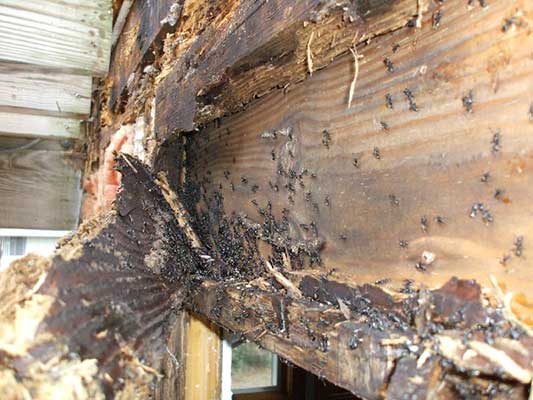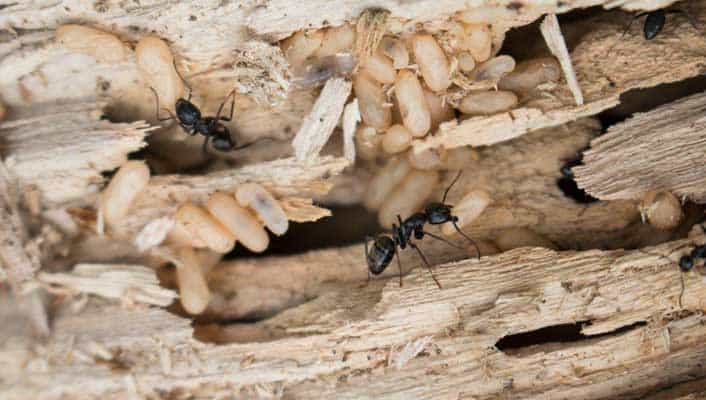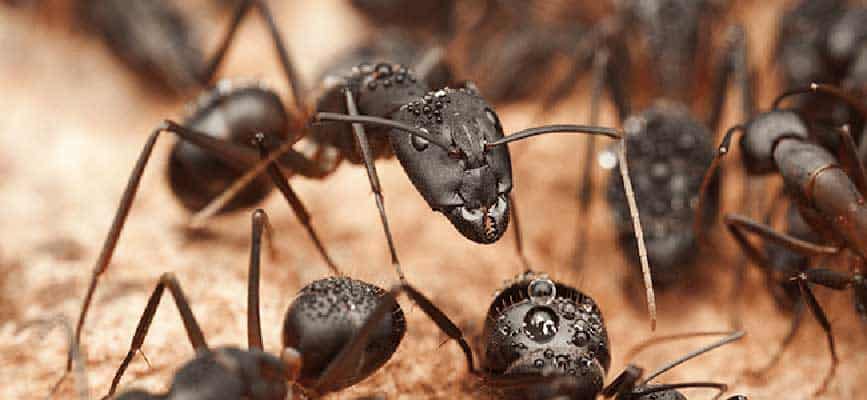Carpenter ants play an essential role in turning decaying wood into sawdust-like material that can quickly rot and get absorbed by plants. Finding carpenter ants in house walls, however, can be a sign that they are wreaking havoc on your home and causing severe damage. As the name suggests, carpenter ants spend their lives hollowing dead and moist wood to create pathways and nests. When they find ideal conditions – damp wood, correct temperature, and security from harsh environmental conditions and predators – their colonies start to thrive and expand.
Although carpenter ants are small and look harmless, they can cause colossal damage to any home. And the trickiest part is that they can establish their nests indoors or outdoors. Since these pests cause injuries that aren’t visible from the outside, knowing when you have a carpenter ant infestation can be challenging. If you see carpenter ants inside your home regularly, you likely have a colony located inside your home. In this piece, we look at three essential questions that you need to answer if you want to get rid of these creatures:
- How do carpenter ants get into your house?
- Which are the most common nesting sites for carpenter ants inside your home?
- What signs indicate the presence of carpenter ants in your house?
How Carpenter Ants Find their Way into Homes
Often carpenter ants go unnoticed until it’s too late since the damage is always internal. That’s why many homeowners ask themselves, how do these pesky pests get inside the house?
These wood-chewing insects love wet and moldy conditions. So, moisture issues in your house means pests to be attracted to the wooden parts in that section. They can then create tunnels through the wet wood and gain access to your home.
Besides chewing their way through moist wood, carpenter ants can also get into your house through cracks or tiny openings on the walls, windows, and doors. Even if these crevices are way above the ground or at the junction between the ceiling and the walls, these pests can use hanging branches or climb up electric wires or pipes to get there.
Lastly, in the carpenter ant colony, a section of ants doesn’t require continuous support or regular feeding. These creatures can survive in reasonably dry locations for a few days before they find wet and temperate zones. Such pests are likely to get into your house through structures with spaces in between, such as insulation attics, wall voids, heating or air-conditioning ducts, and hollow doors.
The Most Common Nesting Places for Carpenter Ants in a House

Once carpenter ants enter houses through cracks or openings, they are likely to target moist wooden parts. They target wood that is spoiled by water through leakages, continuous high relative humidity, or condensation. Typically, these are the most common nesting places for carpenter ants:
- Wooden parts lie next to or beneath clogged gutters, incorrect pitching of porch floors, or damaged flashing. Any wood damaged by water leaking from such areas is a ripe candidate for ants’ infestation.
- Parts around bathrooms and kitchens. Since these areas are always wet, they can soak the wood in the surrounding area, thereby attracting carpenter ants.
- Wooden parts that extend into the ground. Since the soil gets drenched during the rainy season, any wooden part such as siding, porch support, and stair risers can attract these pests.
- You can also find them on leaking door and window frames.
- Poor ventilation or condensation can also cause cellars, attics, under porches, and crawl spaces to be moist, creating a perfect environment for nesting.
- Wooden parts that are damaged by moisture, such as shower and curtain rods, hollow ceiling beams, porch posts, and columns, and wooden doors
- Wooden parts in void or insulation around hot tubs, bathtubs, or showers
While carpenter ants don’t cause as much destruction as termites, when left active for a longer time, they can cause significant damage. So, it’s better to be on the lookout for these invasive creatures and take corrective action once you discover that they have camped in your residence.
Signs that Indicate Ants Infestation in a House
As a homeowner, it’s vitally essential to know some of the things to look out for if you suspect that carpenter ants have found refuge in your house. They include:
- Sawdust-like wood shavings. When carpenter ants chew wood to make nesting tunnels, they excrete sawdust-like materials. The presence of such deposits in the area may indicate infestation.
- Small holes in wooden structures. Though not visible from far, carpenter ants leave tiny grain-size holes in wood. If you discover such spots on wooden parts around your house, it may indicate the presence of carpenter ants.
- Rustling noise from the walls. Sharp rustling noises from the walls may point to a severe infestation.
- Live carpenter ants crawling inside or around your home. Be on the lookout for ants creeping out of the walls, ceilings, and hidden crevices or near the house.
- When you find wings around window sills, baseboards, and door jams, this indicates that the swarmer carpenter ants are in the vicinity and probably inside your house.

How to Get Rid of Carpenter Ants
Once you are sure that these creepy creatures live in your house rent-free, how do you exterminate them completely? Although some homeowners do try, killing carpenter ants is easier said than done. Therefore, you must contact a professional exterminator to help you get rid of carpenter ants. They can use their expertise to locate the nest, eliminate trails and kill them completely.
However, here is what you should do to prevent carpenter ant infestation:
- Prune all branches hanging towards your house and trim back bushes.
- Seal crack and openings in the foundation
- Address and fix water-related issues around your home to ensure that wooden parts are not water damaged.
- Seal all crevices, cracks, and gaps on the walls and ceilings to curtail their movement.
- Tidy up your kitchen and keep all foods and cooking components in airtight containers.
- Keep firewood away from the house and away from any wooden structure.
Remember that the best prevention and elimination of a carpenter ant infestation is to call a professional. Not all carpenter ant exterminators are the same. An experienced company will guarantee the property and make regular visits. There are no shortcuts to eliminating these pests from your home. Keeping materials active in source areas for the gestation period of reproductive cycles is the only approach to ensure your home is wholly eradicated.


